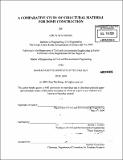A comparative study of structural material for dome construction
Author(s)
Hung, Chun Wai
DownloadFull printable version (32.67Mb)
Other Contributors
Massachusetts Institute of Technology. Dept. of Civil and Environmental Engineering.
Advisor
Jerome J. Connor.
Terms of use
Metadata
Show full item recordAbstract
Unobstructed free space is a pervasive goal in the design of structures intended to provide shelter and protection. This is especially essential for venues such as athletics, spectator activities, and large congregations. The need for such space is constrained by structural feasibility and costs of material and construction. Space structures, and more specifically, the dome structural system is an efficient way to achieve this desired goal. The benefit of domes is that it can be shaped in such a way so that the members are only under axial stresses. Typical construction materials for large span braced domes are dominated by metallic alloys such as steel and aluminum due to their relatively high strength to weight ratio. Timber domes are observed much less frequently. However, recently there is a development of an increase in the use of timber as a structural material due to its potential as a sustainable and more environmental option. Trees can be harvested in a much more sustainable manner than materials such as steel. The aim of this thesis is to compare the advantages and disadvantages of the design and construction of a typical dome structure using differing structural materials of timber and steel. A lamella dome system with the same dimensions and layout was used for the analysis and design of both options. Parameters such as the total self-weight of the structural members, cost, deflection, durability, and sustainability were compared and discussed.
Description
Thesis (M. Eng.)--Massachusetts Institute of Technology, Dept. of Civil and Environmental Engineering, 2009. Includes bibliographical references (p. 79-80).
Date issued
2009Department
Massachusetts Institute of Technology. Department of Civil and Environmental EngineeringPublisher
Massachusetts Institute of Technology
Keywords
Civil and Environmental Engineering.